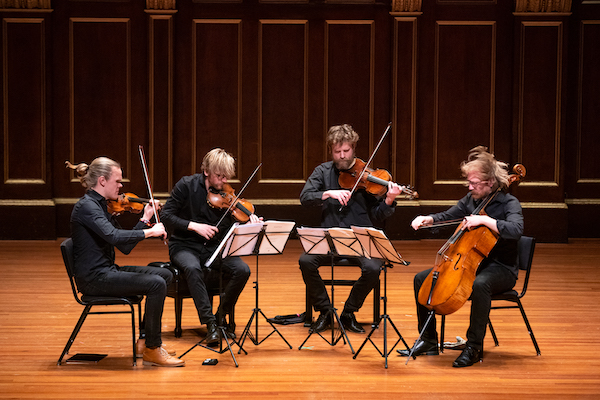From Haydn to Elvis, worlds cohere rather than collide with Danish String Quartet

The Danish String Quartet performed Friday night at Jordan Hall for the Celebrity Series. Photo: Robert Torres
Rarely do Franz Josef Haydn and Elvis Presley find themselves sharing a chamber music program. On the merits of the Danish String Quartet’s exhilarating Friday night appearance at Jordan Hall, though, perhaps they should team up more often.
Then again, there aren’t many groups like these charismatic Scandinavians. Each member—violinists Frederik Øland and Rune Tonsgaard Sørensen, violist Asbjørn Nørgaard, and cellist Fredrik Schøyen Sjölin—is a virtuoso in his own right. However, their collective ensemble truly exceeds the sum of its parts: the ensemble playing is astonishingly unified in articulations, voicings, phrasings, dynamics, and spirit. And it doesn’t matter what they’re playing, as became abundantly clear yesterday evening.
Friday’s program, which marked the ensemble’s third Celebrity Series appearance, was divided into two distinct halves. The first celebrated obscure but mischievous fare by Haydn, Dmitri Shostakovich, and Benjamin Britten. Each of those works—Haydn’s G-minor String Quartet Op. 20, no. 3; Shostakovich’s String Quartet No. 7; and Britten’s Three Divertimenti—are admirably substantial yet concise, making their respective points and then getting out of the way.
On Friday, the Danes mined the humor in Haydn’s abruptness: there was an anarchic, almost Ivesian quality to the outer movements’ sudden endings. More significantly, the ensemble also underlined the rustic leanings of the second movement’s Trio and allowed the gorgeous Poco adagio to sing with unaffected naturalness.
In the Shostakovich, contrasts of character ruled the day. The Allegro was dry and droll, while the dreamy Lento culminated in a long melodic statement of terrifyingly quiet intensity. Meantime, the finale’s contrapuntal figures unspooled with diabolical focus. If the Danish’s reading didn’t solve this enigmatic score’s various mysteries, it at least presented them in a bracing, coherent light.
Much the same happened in their account of Britten’s spastic Divertimenti. The March’s jagged fragments brimmed with color and whimsy. So did the Waltz’s serenely folksy phrases, which also unfurled with a good bit of cheeky elegance. In the concluding Burlesque, devilish violin ostinatos gave way to full-ensemble moments of rhapsodic, jam session-like brio.
All of this set the stage for the night’s second half, which was billed as a celebration of Nordic folk music in arrangements by members of the quartet. In practice, this part of the evening cast a wider geographical net (expanding outward to include Ireland and the Faroe Islands) but all its offerings were united by common lilting and melodic impulses.
Each of the eleven numbers were announced from the stage and played with a tremendous measure of energy and style. They covered much expressive terrain. The lively fare—like the pulsing drones and flying fiddle part in the “Polska from Dorotea” and the foot-stomping refrains on pretty much everything up-tempo—rollicked.
At the same time, the lyrical line always sat front and center. The Danish’s setting of Turlough O’Carolan’s plaintive “Mabel Kelly” was beautifully affecting. So was the night’s highlight—”Når mit Øye”—which all but brought time to a standstill with its pure, hymnlike violin and viola lines rising and falling over a prayerful series of chord progressions anchored by Schøyen Sjölin’s cello.
Occasionally, these pieces directly referenced the evening’s first part. The violin pizzicatos in the Faroe Islands tune, for instance, anticipated the same texture in parts of the Shostakovich and motoric violin ostinatos in the last of the concluding “Three Tunes” (in their world premiere) called to mind a similar gesture in Britten’s Burlesque.
But drawing facile connections between contrasting genres and styles felt far removed from the evening’s purpose, especially given the quartet’s fresh, joyful, and exuberant stage presence. Rather, the Danes, with their visually laid-back but musically locked-in manner, seemed to be subtly emphasizing the arbitrariness and ultimate pointlessness of common musical distinctions. As if to stress that view, they ended the night with a ravishingly beautiful encore of “Can’t Help Falling in Love with You.”
Especially with the latter, they made their point—and channeled Duke Ellington. “There are simply two kinds of music,” the jazz master famously offered, “the good kind and the other kind.” One might add that there are simply two kinds of string quartets: the Danish, and the others.
The Celebrity Series presents violinist Alexi Kenney playing music by J. S. Bach, Reena Esmail, Paul Wiancko, Samuel Adams, Du Yun, Saline Fisher, and Angélica Negrón at 8 p.m. February 22 at Pickman Hall. celebrityseries.org
Posted in Performances